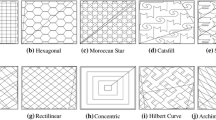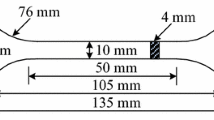Abstract
Parts built using fused deposition modeling (FDM—an additive manufacturing technology) differ from their design model in terms of their microstructure and material properties. These differences lead to a certain amount of ambiguity regarding the structure, strength, and stiffness of the final FDM part. Increasing use of FDM parts as end use products necessitates accurate simulations and analyses during part design. However, analysis methods such as finite element analysis, are used for analysis of continuum models, and may not accurately represent the non-continuous non-linear FDM parts. Therefore, it is necessary to determine the accuracy and precision of FEA for FDM parts. The goal of this study is to compare FEA simulations of the as-built geometries with the experimental tests of actual FDM parts. Dogbone geometries that include different infill patterns are tested under tensile loading and later simulated using FEA. This study found that FEA results are not always an accurate or reliable means of predicting FDM part behaviors.











Similar content being viewed by others
Data availability
Data concerning this research is available through Clemson University by request to the corresponding author.
References
Reddy, J.N. (2006). An introduction to the finite element method (Third Ed.). McGraw-Hill. ISBN 9780071267618.
Mamadapur, M. S. (2007). Constitutive modeling of fused deposition modeling acrylonitrile butadiene styrene (ABS) (Doctoral dissertation, Texas A&M University).
https://www.stratasysdirect.com/solutions/fused-deposition-modeling/
http://proto3000.com/fused-deposition-modeling-solutions-fdm-3d-printing-applications.php
Upadhyay K, Dwivedi R, Singh AK (2017) Determination and comparison of the anisotropic strengths of fused deposition modeling P400 ABS. In: Advances in 3D Printing & Additive Manufacturing Technologies. Springer, Singapore, pp 9–28
Es-Said OS, Foyos J, Noorani R, Mendelson M, Marloth R, Pregger BA (2000) Effect of layer orientation on mechanical properties of rapid prototyped samples. Mater Manuf Process 15(1):107–122
Gajdoš I, Slota J (2013) Influence of printing conditions on structure in FDM prototypes. Tech Gazette 20(2):231–236
Bellehumeur C, Li L, Sun Q, Gu P (2004) Modeling of bond formation between polymer filaments in the fused deposition modeling process. J Manuf Process 6(2):170–178
Sun Q, Rizvi GM, Bellehumeur CT, Gu P (2008) Effect of processing conditions on the bonding quality of FDM polymer filaments. Rapid Prototyp J 14(2):72–80
Ahn SH, Montero M, Odell D, Roundy S, Wright PK (2002) Anisotropic material properties of fused deposition modeling ABS. Rapid Prototyp J 8(4):248–257
Montero M, Roundy S, Odell D, Ahn SH, Wright PK (2001) Material characterization of fused deposition modeling (FDM) ABS by designed experiments. Soc Manuf Eng 10(13552540210441166)
Wu W, Geng P, Li G, Zhao D, Zhang H, Zhao J (2015) Influence of layer thickness and raster angle on the mechanical properties of 3D-printed PEEK and a comparative mechanical study between PEEK and ABS. Materials 8(9):5834–5846
Syamsuzzaman M, Mardi NA, Fadzil M, Farazila Y (2014) Investigation of layer thickness effect on the performance of low-cost and commercial fused deposition modelling printers. Mater Res Innov 18(sup6):6–485
Ziemian, C., Sharma, M., & Ziemian, S. (2012). Anisotropic mechanical properties of ABS parts fabricated by fused deposition modelling. INTECH Open Access Publisher
Zou R, **a Y, Liu S, Hu P, Hou W, Hu Q, Shan C (2016) Isotropic and anisotropic elasticity and yielding of 3D printed material. Compos Part B 99:506–513
Casavola C, Cazzato A, Moramarco V, Pappalettere C (2016) Orthotropic mechanical properties of fused deposition modelling parts described by classical laminate theory. Mater Des 90:453–458
Bertoldi M, Yardimci MA, Pistor CM, Guceri SI, Sala G (1998) Mechanical characterization of parts processed via fused deposition. In: Proceedings of the 1998 solid freeform fabrication symposium, pp 557–565
Magalhães LC, Volpato N, Luersen MA (2014) Evaluation of stiffness and strength in fused deposition sandwich specimens. J Braz Soc Mech Sci Eng 36(3):449–459
Alaimo G, Marconi S, Costato L, Auricchio F (2017) Influence of meso-structure and chemical composition on FDM 3D-printed parts. Compos Part B 113:371–380
Dutta D (1999) Deposition strategies and resulting part stiffnesses in fused deposition modeling. Ann Arbor 1050:48109
Hambali RH, Celik HK, Smith PC, Rennie AEW, Ucar M (2010, September) Effect of build orientation on FDM parts: a case study for validation of deformation behaviour by FEA. In: Proceedings of iDECON 2010—international conference on design and concurrent engineering. Universiti Teknikal Malaysia Melaka, Melaka, pp 224–228
Hambali RH, Smith P, Rennie AEW (2012) Determination of the effect of part orientation to the strength value on additive manufacturing FDM for end-use parts by physical testing and validation via three-dimensional finite element analysis. Int J Mater Eng Innov 3(3-4):269–281
Domingo-Espin M, Puigoriol-Forcada JM, Garcia-Granada AA, Llumà J, Borros S, Reyes G (2015) Mechanical property characterization and simulation of fused deposition modeling polycarbonate parts. Mater Des 83:670–677
Cuan-Urquizo, E., Yang, S., & Bhaskar, A. (2015). Mechanical characterisation of additively manufactured material having lattice microstructure. In IOP Conference Series: Materials Science and Engineering (74, 1, p. 012004). IOP Publishing.
Villalpando L, Eiliat H, Urbanic RJ (2014) An optimization approach for components built by fused deposition modeling with parametric internal structures. Procedia CIRP 17:800–805
Rezayat H, Zhou W, Siriruk A, Penumadu D, Babu SS (2015) Structure–mechanical property relationship in fused deposition modelling. Mater Sci Technol 31(8):895–903
Garg A, Bhattacharya A (2017) An insight to the failure of FDM parts under tensile loading: finite element analysis and experimental study. Int J Mech Sci 120:225–236
El-Gizawy, A. S., Corl, S., & Graybill, B. (2011). Process-induced properties of fdm products. In Proceedings of the ICMET, International Conference on Mechanical Engineerings and Technology Congress & Exposition.
Martínez J, Diéguez JL, Ares E, Pereira A, Hernández P, Pérez JA (2013) Comparative between FEM models for FDM parts and their approach to a real mechanical behaviour. Procedia Eng 63:878–884
Sayre III, R. (2014). A comparative finite element stress analysis of isotropic and fusion deposited 3D printed polymer (Doctoral dissertation, Rensselaer Polytechnic Institute).
Michopoulos JG, Hermanson JC, Iliopoulos A (2014) Advances on the constitutive characterization of composites via multiaxial robotic testing and design optimization. Adv Comput Info Eng Res 1:73–95
Steuben JC, Iliopoulos AP, Michopoulos JG (2016) Discrete element modeling of particle-based additive manufacturing processes. Comput Methods Appl Mech Eng 305:537–561
Baikerikar PJ (2017) Comparison of as-built FEA simulations and experimental results for additively manufactured dogbone geometries (master’s thesis). Department of Mechanical Engineering, Clemson University, Clemson, SC May 2017
Acknowledgements
The work presented in this paper is developed from the thesis work of Baikerikar [37]. The authors wish to gratefully acknowledge the support of the Clemson University Mechanical Engineering Department, and Dr. Garrett Pataky for providing access to the load testing equipment in his laboratory.
Funding
Support for this research was provided by Clemson University through the Department of Mechanical Engineering, with access to load testing equipment provided by Dr. Garrett Pataky of the Department of Mechanical Engineering at Clemson University.
Author information
Authors and Affiliations
Contributions
Both authors have made substantial contributions to this research.
Corresponding author
Ethics declarations
Ethics approval
All research was conducted according the ethical standards and guidelines established by Clemson University.
Consent to participate
No human or animal subjects were used in this study.
Consent for publication
By submission, the authors grant consent to publish the results of their research.
Competing interests
All authors certify that they have no affiliations with or involvement in any organization or entity with any financial interest or non-financial interest in the subject matter or materials discussed in this manuscript.
Additional information
Publisher’s note
Springer Nature remains neutral with regard to jurisdictional claims in published maps and institutional affiliations.
Supplementary Information
ESM 1
(DOCX 1.52 MB)
Rights and permissions
About this article
Cite this article
Baikerikar, P., Turner, C.J. Comparison of FEA simulations and experimental results for as-built additively manufactured dogbone specimens. Int J Adv Manuf Technol 115, 2839–2851 (2021). https://doi.org/10.1007/s00170-021-07307-9
Received:
Accepted:
Published:
Issue Date:
DOI: https://doi.org/10.1007/s00170-021-07307-9




